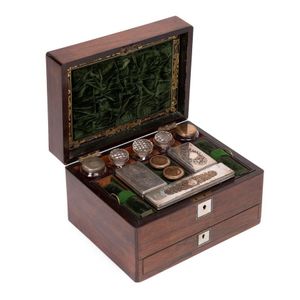Victorian Rosewood Travel Case with Sterling Silver Lids
You must be a subscriber, and be logged in to view price and dealer details.
Subscribe Now to view actual auction price for this item
When you subscribe, you have the option of setting the currency in which to display prices to $Au, $US, $NZ or Stg.
- Sterling Silver - Sterling silver is a mixture of 92.5% pure silver and 7.5% of another metal, usually copper. Fine silver is 99.9% pure silver, and is relatively soft and the addition of the very small amount of copper gives the metal enough strength and hardness to be worked into jewellery, decorative and household objects.
- Victorian Period - The Victorian period of furniture and decorative arts design covers the reign of Queen Victoria from 1837 to 1901. There was not one dominant style of furniture in the Victorian period. Designers used and modified many historical styles such as Gothic, Tudor, Elizabethan, English Rococo, Neoclassical and others, although use of some styles, such as English Rococo and Gothic tended to dominate the furniture manufacture of the period.
The Victorian period was preceded by the Regency and William IV periods, and followed by the Edwardian period, named for Edward VII (1841 ? 1910) who was King of the United Kingdom and the British Dominions and Emperor of India for the brief period from 1901 until his death in 1910. - Rosewood - A dense timber that varies in shade to very light brown to almost black. When rosewood is cut and sanded the colour of the timber will turn black, and after polishing and exposure to daylight, the surface will gradually lighten over time to light brown with black streaks.
The name comes from the odour emanating from the timber when it is planed, sanded or cut.
Rosewood was very popular for use in Victorian furniture in the second half of the 19th century, and at that time most of the rosewood was imported from Brazil. However it also grows in India and Indonesia.
It is used in the sold for chairs and table legs, but for carcase furniture such as side cabinets and bookcases, and for table tops it is always used as a veneer.
This item has been included into following indexes:
Visually similar items

An early-20th century Dutch tortoiseshell case silver coffee spoon set C. 1910, the case with raised domed lid and serpentine front, ivory border rim with bun feet. Twelve silver spoons and sugar shovel (lock no key). Dimensions 15 cm x 18.5 cm

A Victorian rosewood ladies travelling dressing box, fitted with crystal and silver plated jars and green velvet lined compartments, circa 1880, 18 cm high, 30 cm wide, 22 cm deep.

Fine antique figured walnut sterling mounted toilet box, pop out jewellery drawer below, retailed by Toulmin & Gale Cheapside and new Bond St London dated London WN 1868

Writing Boxes: Two 19th century amboyna writing slopes. Height 16 cm, width 35 cm, depth 25 cm approx.
